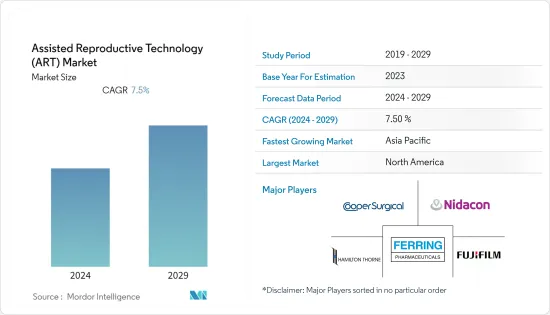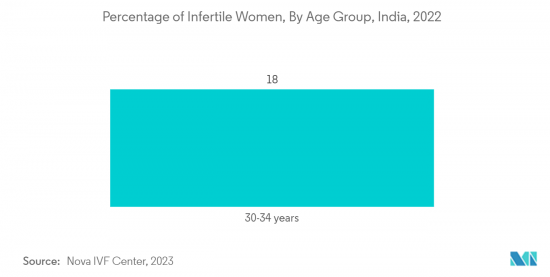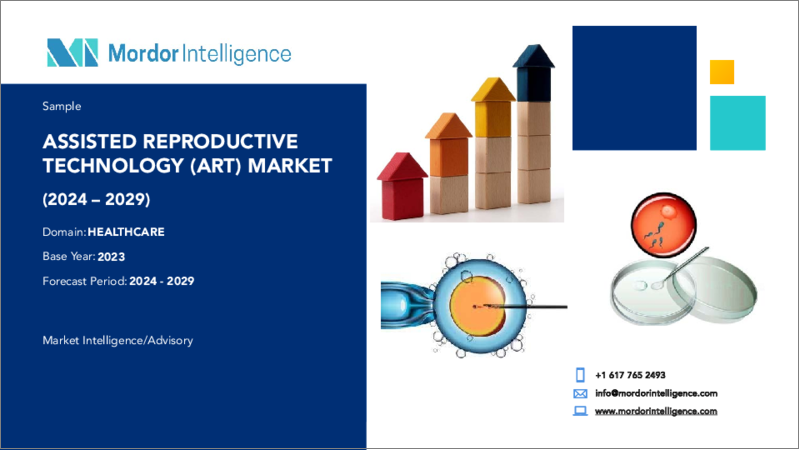|
|
市場調査レポート
商品コード
1404382
生殖補助医療(ART):市場シェア分析、産業動向・統計、2024~2029年成長予測Assisted Reproductive Technology (ART) - Market Share Analysis, Industry Trends & Statistics, Growth Forecasts 2024 - 2029 |
||||||
|
● お客様のご希望に応じて、既存データの加工や未掲載情報(例:国別セグメント)の追加などの対応が可能です。 詳細はお問い合わせください。 |
|||||||
| 生殖補助医療(ART):市場シェア分析、産業動向・統計、2024~2029年成長予測 |
|
出版日: 2024年01月04日
発行: Mordor Intelligence
ページ情報: 英文 120 Pages
納期: 2~3営業日
|
- 全表示
- 概要
- 目次
生殖補助医療技術市場は予測期間(2024-2029)にCAGR 7.5%を記録すると予測されます。

主なハイライト
- 新規COVID-19による社会的・経済的負担の増大は、ヘルスケア部門にとって次第に憂慮すべきものとなった。様々な調査により、新型コロナウイルスは、卵巣、子宮、膣、胎盤に広く発現しているアンジオテンシン変換酵素2(ACE2)に結合して標的細胞に侵入することが判明しました。さらに、パンデミックが出生率に与える影響に関する調査研究も発表されています。
- 例えば、2021年2月にBMJ Open Journalに掲載された調査研究では、SARS-CoV-2はACE2を調節し、ART処置を妨害することによって女性の生殖能力を阻害すると述べられています。したがって、パンデミックの間、不妊治療が増加し、市場の成長にかなり影響を与えました。COVID-19症例の減少と大規模なワクチン接種により、調査対象市場は予測期間中に完全な潜在力を取り戻すと予想されます。
- 晩婚化による不妊症の増加、ストレスの多いライフスタイル、肥満、ジャンクフードの多量摂取、喫煙、アルコール中毒、薬物中毒などの要因がARTの採用を促進しています。
- 例えば、2022年12月に国立医薬品図書館で発表された女性の不妊症に関するデータによると、世界全体では、過去に生児を出産した女性の11%が次の生児を出産できず、20歳から44歳の女性の2%が全く生児を出産できませんでした。上記の資料によると、不妊率は東欧、北アフリカ、中東で高く出ています。したがって、不妊率が高いため、ART技術に対する需要は年々増加し、市場の成長を牽引すると予想されます。
- さらに、世界のさまざまな地域における出生率の低下と老年人口の急増は、ART市場に大きな影響を与えると予想されます。例えば、ユーロスタットが2022年4月に更新したデータによると、欧州連合(EU)の粗出生率(人口1,000人当たりの出生数)は徐々に低下しており、近年は9.1に達しています。したがって、ART技術に対する需要は予測期間中に拡大し、市場全体の成長を促進すると予想されます。
- さらに、シングルペアレントの増加や、同性婚や生殖補助医療技術に対する認識も、予測期間におけるART市場の成長に大きな役割を果たすと予想されます。例えば、ヒューマン・ライツ・キャンペーン(HRC)財団の2022年最新情報によると、同性婚が合法である国は2022年には32カ国に増加し、いくつかの国で議会または裁判手続きが進行中であり、この数はさらに増加すると予想されています。このように、同性婚の増加に伴い、ART技術に対する需要が大幅に増加することが予想され、研究対象市場の成長を後押しします。
- しかし、社会倫理的な問題やARTに関連する高額な費用とともに、政府の規制が変化することが生殖補助医療(ART)市場の成長を抑制すると予想され、予測期間中の成長が期待されます。
生殖補助医療(ART)市場の動向
体外受精(IVF)は予測期間中に大きく成長する見込み
- 自然妊娠や従来の方法と比べ、体外受精(IVF)は大きく異なります。医師が性行動や不妊の具体的な原因を特定しようとする不妊検査の後、頻繁に治療が行われます。医師は卵巣の卵子を摘出し、研究室で受精させ、受精卵は生存可能な胚になるまで良好な環境で保存されます。この時点で、1つは母親の子宮に戻されます。妊娠しにくい体質による負担の増加により、生殖年齢にある女性の間で体外受精の需要が増加しており、同分野の成長を牽引すると予想されています。
- 体外受精分野は、高い成功率と継続的な進歩により成長が見込まれています。例えば、Kin Fertility Clinicが2023年5月に発表した記事によると、近年、オーストラリアでは30歳未満の女性の体外受精の成功率は21.2%であることが判明しており、年齢、胚の質、ライフスタイルの要因が体外受精の成功の主要因の一つとなっています。したがって、体外受精の成功率が高いことから、同分野は予測期間中に大きく成長すると予想されます。
- さらに、体外受精技術の進歩、意識の高まり、代理出産を規制する政府の取り組み、保険による体外受精の適用範囲の拡大は、生殖補助医療(ART)の成長に重要な役割を果たすと予想されるその他の主な要因です。例えば、2022年6月、インドのオディシャ州は、体外受精クリニックを規制し、商業的代理出産を禁止する目的で、州当局を構成し、州生殖補助医療・代理出産委員会を設立しました。
- 生殖補助医療(ART)法は、法的、倫理的、社会的な争いと闘う不妊カップルにとって希望の光となりました。体外受精とARTクリニックは、保健家族福祉省の特別長官(公衆衛生)を長とする5人のメンバーからなる当局の承認を経て、登録されることになります。したがって、このような取り組みは、今後の市場成長を増加させると思われます。

予測期間中、北米が主要市場シェアを占める見込み
- 北米は、同地域における不妊症の増加や公的機関による取り組みなどの要因により、予測期間にわたって世界の生殖補助医療技術市場で大きな市場シェアを占めると予想されます。
- 北米地域の米国は、強固なヘルスケアインフラと不妊症の減少により、予測期間を通じて生殖補助医療(ART)市場の主要市場になると予想されます。例えば、国勢調査局が2022年4月に更新したデータによると、20~24歳の女性の出生率は近年43%低下しており、同年齢層の女性1,000人当たりの出生数はわずか66.59人で、米国では過去数十年から出生率が42.79%低下していることが示されています。
- さらに、米国国立衛生研究所(NIH)が2023年1月に発表した研究によれば、米国では生殖年齢、すなわち18歳から35歳の女性の11%近くが、近年不妊の問題を経験しています。このように、女性の間で不妊症の割合が増加していることから、ART技術の需要が増加し、この地域の市場全体の成長を牽引すると予想されます。
- さらに、同地域に存在するクリニックの数は、ART導入の機会を創出し、北米市場の成長を促進すると予想されます。例えば、米国疾病予防管理センター(CDC)が2023年3月に更新したデータによると、米国では約500のクリニックが不妊症を克服しようとする患者にサービスを提供しています。CDCは米国内のすべての不妊治療クリニックからデータを収集し、各クリニックの標準成功率を算出しています。これにより、潜在的なART利用者は、成功の平均確率を知ることができます。したがって、ARTユーザーやサービスを提供するクリニックがこのようなデータを入手できることは、分析期間中の同分野の成長を促進すると予想されます。
- さらに、ART技術の進歩や新製品の発売が市場の成長を後押しすると予想されます。例えば、2022年6月、FUJIFILM Irvine Scientific, Inc.は、体外受精ラボに使いやすさと保護の理想的なバランスを提供する最適な重量粘度の無菌鉱物油「胚培養用ヘビーオイル」を発売しました。したがって、前述の要因により、北米が調査市場において大きなシェアを占めると予想されます。
生殖補助医療(ART)産業の概要
生殖補助医療(ART)市場の競争は中程度であり、市場にはいくつかの主要企業が存在します。生殖補助医療(ART)市場の主要企業には、Bloom IVF Centre、CooperSurgical Inc.、Ferring B.V.、Hamilton Thorne Inc.、FUJIFILM Irvine Scientific, Inc.、Laboratoire CCD、Microm Ltd.、Nidacon International AB、OvaScience Inc.、Vitrolifeなどがあります。
その他の特典:
- エクセル形式の市場予測(ME)シート
- 3ヶ月間のアナリスト・サポート
目次
第1章 イントロダクション
- 調査の前提条件と市場定義
- 調査範囲
第2章 調査手法
第3章 エグゼクティブサマリー
第4章 市場力学
- 市場概要
- 市場促進要因
- 不妊症患者数の増加
- 独身女性と同性カップルの増加
- 体外受精と代理出産に対する意識の高まり
- 市場抑制要因
- 高コストと社会倫理的問題
- 政府規制の変化
- ポーターのファイブフォース分析
- 新規参入業者の脅威
- 買い手/消費者の交渉力
- 供給企業の交渉力
- 代替品の脅威
- 競争企業間の敵対関係の強さ
第5章 市場セグメンテーション(市場規模)
- 技術別
- 体外受精(IVF)
- 人工授精(AI-IUI)
- 凍結胚移植(FER)
- その他
- エンドユーザー別
- 病院
- 不妊治療クリニック
- 地域別
- 北米
- 米国
- カナダ
- メキシコ
- 欧州
- ドイツ
- 英国
- フランス
- イタリア
- スペイン
- その他の欧州
- アジア太平洋
- 中国
- 日本
- インド
- オーストラリア
- 韓国
- その他のアジア太平洋地域
- 中東・アフリカ
- GCC
- 南アフリカ
- その他の中東とアフリカ
- 南米
- ブラジル
- アルゼンチン
- その他の南米
- 北米
第6章 競合情勢
- 企業プロファイル
- Bloom IVF Centre
- CooperSurgical Inc.
- Ferring B.V.
- Hamilton Thorne Inc.
- FUJIFILM Irvine Scientific, Inc.
- Laboratoire CCD
- Microm Ltd
- Nidacon International AB
- OvaScience Inc.
- Vitrolife
- Esco Medical
- Memmert GmbH+Co.KG
第7章 市場機会と今後の動向

The Assisted Reproductive Technology Market is expected to register a CAGR of 7.5% during the forecast period(2024-2029).
The global assisted reproductive technology (ART) market size is expected to register a CAGR of 7.5% during the forecast period.
Key Highlights
- The increased social and economic burden caused by the novel COVID-19 gradually became worrisome for the healthcare sector. Various research found that the novel coronavirus invades the target cell by binding to angiotensin-converting enzyme 2 (ACE2), which is widely expressed in the ovaries, uterus, vagina, and placenta. In addition, research studies have been published on the impact of the pandemic on the fertility rate.
- For instance, a research study published in the BMJ Open Journal in February 2021 stated that SARS-CoV-2 interrupts female fertility by regulating ACE2 and interfering with ART procedures. Hence, fertility treatments increased during the pandemic and affected the market growth considerably. With the declining COVID-19 cases and large-scale vaccination, the studied market is expected to regain its full potential over the forecast period.
- Factors such as rising cases of infertility due to late marriages, stressful lifestyles, obesity, high junk food intake, smoking, alcoholism, and drug addiction are driving the adoption of ART.
- For instance, according to the data published on female infertility in the National Library of Medicines in December 2022, globally, 11% of women who had a previous live birth were unable to have another, and 2% of women aged 20 to 44 were unable to have any live births at all. As per the above source, infertility rates are higher in Eastern Europe, North Africa, and the Middle East. Hence, owing to the higher infertility, the demand for ART techniques is expected to increase over the years and drive the growth of the market.
- Further, the declining birth rate in different regions across the world and the rapid increase in the geriatric population are expected to have a significant impact on the ART market. For instance, according to the data update by Eurostat in April 2022, the crude birth rate (the number of live births per 1,000 persons) in the European Union is declining gradually, reaching 9.1 in recent years. Hence, the demand for ART technology is expected to grow over the forecast period, fueling the overall market growth.
- In addition, the increasing number of single parents and awareness about same-sex marriages and assisted reproductive technologies are also expected to play a significant role in the growth of the ART market over the forecast period. For instance, according to the 2022 update of the Human Rights Campaign (HRC) Foundation, the number of countries where same-sex marriage is legal has increased to 32 in 2022, and parliamentary or court proceedings are underway in several countries, and this number is further expected to increase. Thus, with the increase in same-sex marriages, the demand for ART techniques is expected to increase significantly, which will boost growth in the studied market.
- However, changing government regulations along with socio-ethical issues and high costs associated with ART are expected to restrain the growth of the assisted reproductive technologies (ART) market is expected to grow during the forecast period.
Assisted Reproductive Technology (ART) Market Trends
In-Vitro Fertilization (IVF) Segment is Expected to Grow Significantly During the Forecast Period
- Compared to natural and conventional ways of conception, in vitro fertilization (IVF) is very different; following an infertility test, when the doctor tries to determine sexual behaviors and any specific causes of infertility, the treatment is frequently administered. The doctor removes the ovaries' eggs, which are then fertilized in a lab, and the fertilized eggs are then kept in an environment that is favorable until they become viable embryos. At this point, one is returned to the mother's womb. Due to the rising burden of lack of natural tendency to conceive, the demand for IVF is increasing among women of reproductive age and is expected to drive the segment's growth.
- The IVF segment is expected to grow due to the high procedural success rate and continuous advancement. For instance, according to an article published in May 2023 by Kin Fertility Clinic, in recent years, the success rate for IVF for women under 30 was found to be 21.2% in Australia, and age, quality of the embryo, and lifestyle factors are among the major factors for the success of an IVF procedure. Hence, due to the success rate of the procedure, the segment is expected to grow significantly during the forecast period.
- Moreover, the advancement in IVF technology, growing awareness, government initiatives to regulate surrogacy, and increasing coverage of IVF under insurance are the other major factors expected to play a crucial role in the growth of the studied segment. For instance, in June 2022, the Indian state Odisha constituted a state-appropriate authority and set up the state-assisted reproductive technology and surrogacy board with the objective of regulating IVF clinics and prohibiting commercial surrogacy.
- The Assisted Reproductive Technology (ART) Act came as a ray of hope for infertile couples battling legal, ethical, and social tussles. The IVF and ART clinics will now be registered following the approval of the five-member authority led by the Special Secretary (Public Health) of the Health and Family Welfare Department. Hence, such initiatives would increase market growth in the upcoming period.

North America is Expected to Occupy a Major Market Share Over the Forecast Period
- North America is expected to hold a significant market share in the global assisted reproductive technology market over the forecast period owing to factors such as increasing infertility in the region and initiatives by public organizations.
- The United States in the North American region is expected to be a major market for the assisted reproductive technology (ART) market over the forecast period due to the robust healthcare infrastructure and decreasing fertility. For example, data updated by the Census Bureau in April 2022 showed that fertility rates of women ages 20-24 declined by 43% in recent years, with only 66.59 births to every 1,000 women in that age range, indicating a 42.79% decline in fertility from past decades in the United States.
- Furthermore, as per a study published by the National Institute of Health (NIH) in January 2023, nearly 11% of women of reproductive age, i.e., 18 to 35 years in the United States, have experienced fertility problems in current years. Thus, with the increasing rate of infertility among women, the demand for ART techniques is expected to increase and drive the overall market growth in the region.
- Furthermore, the number of clinics present in the region is expected to create opportunities for the adoption of ART and drive the market's growth in North America. For instance, according to the data updated by Centers for Disease Control and Prevention (CDC) in March 2023, nearly 500 clinics provide services to patients seeking to overcome infertility in the United States. CDC collects data from all fertility clinics in the United States and calculates standardized success rates for each clinic. This gives potential ART users an idea of their average chances of success. Hence, the availability of such data for ART users and clinics offering services is anticipated to fuel the segment's growth over the analysis period.
- Further, the advancements in ART technology and the launch of new products are expected to boost the market's growth. For instance, in June 2022, FUJIFILM Irvine Scientific, Inc. launched Heavy Oil for Embryo Culture, a sterile mineral oil with an optimal weight viscosity that provides the ideal balance between ease of use and protection for IVF laboratory. Therefore, due to the aforementioned factors, North America is expected to have a major market share in the studied market.
Assisted Reproductive Technology (ART) Industry Overview
The assisted reproductive technology (ART) market is moderately competitive, with the presence of some key players in the market. The key player in the assisted reproductive technology (ART) market includes - Bloom IVF Centre, CooperSurgical Inc., Ferring B.V., Hamilton Thorne Inc., FUJIFILM Irvine Scientific, Inc., Laboratoire CCD, Microm Ltd, Nidacon International AB, OvaScience Inc., and Vitrolife.
Additional Benefits:
- The market estimate (ME) sheet in Excel format
- 3 months of analyst support
TABLE OF CONTENTS
1 INTRODUCTION
- 1.1 Study Assumptions and Market Definition
- 1.2 Scope of the Study
2 RESEARCH METHODOLOGY
3 EXECUTIVE SUMMARY
4 MARKET DYNAMICS
- 4.1 Market Overview
- 4.2 Market Drivers
- 4.2.1 Increasing Number of Infertility Cases
- 4.2.2 Rise in Number of Single Women and Same-sex Couples
- 4.2.3 Increase in Awareness for IVF and Surrogacy
- 4.3 Market Restraints
- 4.3.1 High Cost and Socio-ethical Issues
- 4.3.2 Changing Government Regulations
- 4.4 Porter's Five Forces Analysis
- 4.4.1 Threat of New Entrants
- 4.4.2 Bargaining Power of Buyers/Consumers
- 4.4.3 Bargaining Power of Suppliers
- 4.4.4 Threat of Substitute Products
- 4.4.5 Intensity of Competitive Rivalry
5 MARKET SEGMENTATION (Market Size by Value - USD)
- 5.1 By Technology
- 5.1.1 In Vitro-fertilization (IVF)
- 5.1.2 Artificial Insemination (AI-IUI)
- 5.1.3 Frozen Embryo Replacement (FER)
- 5.1.4 Others
- 5.2 By End Users
- 5.2.1 Hospital
- 5.2.2 Fertility Clinics
- 5.3 Geography
- 5.3.1 North America
- 5.3.1.1 United States
- 5.3.1.2 Canada
- 5.3.1.3 Mexico
- 5.3.2 Europe
- 5.3.2.1 Germany
- 5.3.2.2 United Kingdom
- 5.3.2.3 France
- 5.3.2.4 Italy
- 5.3.2.5 Spain
- 5.3.2.6 Rest of Europe
- 5.3.3 Asia-Pacific
- 5.3.3.1 China
- 5.3.3.2 Japan
- 5.3.3.3 India
- 5.3.3.4 Australia
- 5.3.3.5 South Korea
- 5.3.3.6 Rest of Asia-Pacific
- 5.3.4 Middle East and Africa
- 5.3.4.1 GCC
- 5.3.4.2 South Africa
- 5.3.4.3 Rest of Middle East and Africa
- 5.3.5 South America
- 5.3.5.1 Brazil
- 5.3.5.2 Argentina
- 5.3.5.3 Rest of South America
- 5.3.1 North America
6 COMPETITIVE LANDSCAPE
- 6.1 Company Profiles
- 6.1.1 Bloom IVF Centre
- 6.1.2 CooperSurgical Inc.
- 6.1.3 Ferring B.V.
- 6.1.4 Hamilton Thorne Inc.
- 6.1.5 FUJIFILM Irvine Scientific, Inc.
- 6.1.6 Laboratoire CCD
- 6.1.7 Microm Ltd
- 6.1.8 Nidacon International AB
- 6.1.9 OvaScience Inc.
- 6.1.10 Vitrolife
- 6.1.11 Esco Medical
- 6.1.12 Memmert GmbH + Co.KG




